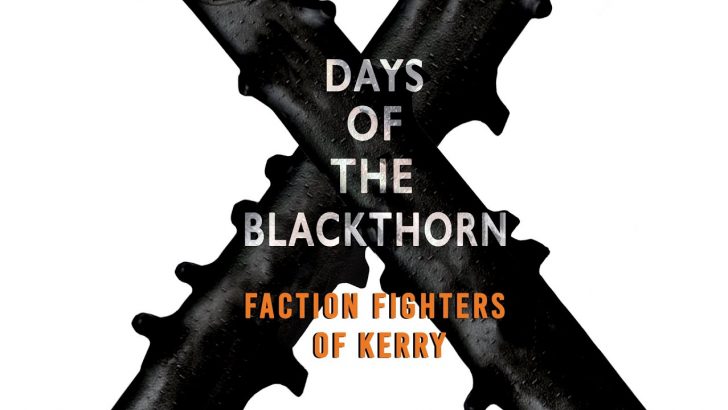Days of the Blackthorn: Faction Fighters of Kerry
by Seán Moraghan (Mercier Press, €16.99)
In the early part of the 19th Century especially, faction fighting was a feature of rural life throughout Munster.
The Catholic clergy were unable to prevent it, despite their strenuous efforts, local magistrates turned a Nelson eye on it and some landlords actively encouraged it. Hardly a fair concluded without a faction fight taking place.
The most celebrated faction fighters were the ‘Caravats’ and the ‘Shanavests’ of Limerick, Tipperary and Waterford, the ‘three-year-olds’ and the ‘four-year-olds’ of both Limerick and Tipperary, the ‘Coffeys’ and ‘Reaskawallahs’ (Ryans) of the area along the Limerick–Tipperary border, the ‘Ryans’, and ‘Dwyers’ of the district around Cashel and the ‘Cooleens’ and ‘Lawlor–Mulvihills’ of north Kerry.
Fairs
Apart from fairs, faction fighting took place on town streets, green fields and at race meetings and Saints’ patron days. The rival factions attacked each other with cudgels, blackthorn sticks, reaping hooks and even guns.
Hundreds and sometimes even thousands of men and women were involved. The women employed the same strategy as was adopted by David when he vanquished the giant Goliath in the Bible story. This faction fighting continued in one form or another for more than 200 years.
An initial police report on July 7 stated that the number of the dead totalled 18”
Many faction fights were held across Co. Kerry. Factions squared off frequently in Tralee, the county town.
Similarly, faction fighting was rife in Killarney, where the ‘Moynihans’ and the ‘O’Donoghues’ were in a state of perpetual feud for half a century. In Castleisland the ‘Brosnahans’ regularly clashed with the ‘O’Connors’. At Ballymacelligott the ‘Carmody’s’ faced up to the ‘Slatterys’. The major annual faction fight in Dingle was between the ‘Fitzgeralds (Na Gearaltaigh)’ and the ‘Moriartys’. It was claimed that the enmity between these parties stemmed from the betrayal of the Earl of Desmond – a Fitzgerald – by a Moriarty in 1583!
The Beara Peninsula, Cahirciveen, Kenmare, Killorglin (at Puck Fair) and the Sliabh Luachra area all had their ritualistic faction fighting.
The faction fighters were involved in riots surrounding the county elections in the 19th Century. In every instance fighting was fuelled by an excessive consumption of whiskey by the combatants.
The most notorious faction fight was held at the race meeting on Ballyeagh Strand, near Ballybunion, on St John’s day, June 24, 1834. The ‘Cooleens’ crossed the Cashen river to challenge the ‘Lawlor-Mulvihills’. According to a subsequent police report 1,000 people were involved in the fight on the side of the ‘Cooleens’ and about 1,500 on the side of the ‘Lawlor-Mulvihills’.
Battles
With such numbers involved – in fact, more than took part in a number of important battles in Irish history – it is not surprising that there was serious loss of life. Because of the greater numbers on the opposite side the ‘Cooleens’ were driven back to the water’s edge. When they attempted to get into their boats and escape they were savagely set upon, some were bludgeoned to death on the strand, others were drowned.
An initial police report on July 7 stated that the number of the dead totalled 18. But a later report recorded that 29 ‘Cooleens’ had been killed, while among the Lawlor-Mulvihills 12 “were carried home with broken jaws, hands and legs”.
As a result of the public outcry at the appalling loss of life, no faction fight was ever again held on Ballyeagh strand and some years later the race meeting was transferred to Listowel.
Faction fighting petered out rather than ended. There were a number of influences to this end. Bishops excommunicated and parish priests censured from the altar the organisers of fights, O’Connell railed against them. Fr Mathew’s Temperance Movement discouraged the excessive drinking.
The Land War in the 1890s absorbed the attention of the leaders of the various factions. Magistrates and the police implemented the law more forcibly with regard to faction fighting.
A vote of thanks is due to Seán Moraghan and his distinguished predecessors in the field”
Following the establishment of the GAA, teams were formed on which leaders of opposing factions played side by side.
Nationalists were embarrassed by the savagery and thuggery at the heart of the faction fighting. Hence it has tended to be overlooked and even ignored completely by academic historians. Yet it was an integral part of the social history of 18th and 19th Century Ireland.
Thus, a vote of thanks is due to Seán Moraghan and his distinguished predecessors in the field – Pádraig de Brún and Patrick O’Donnell – for recording this important yet neglected element of our country’s recent history.


 mercierpress.ie
mercierpress.ie 
